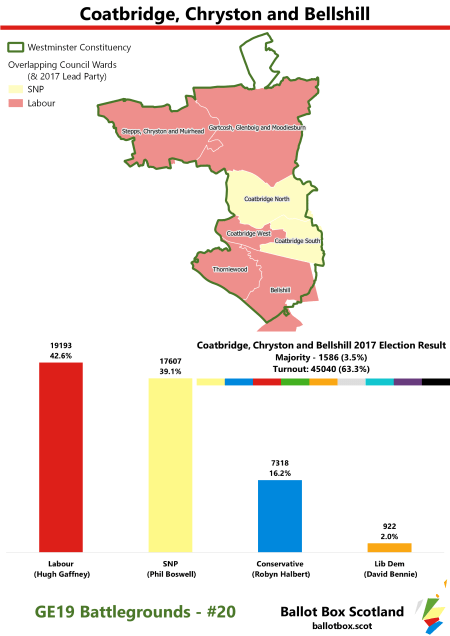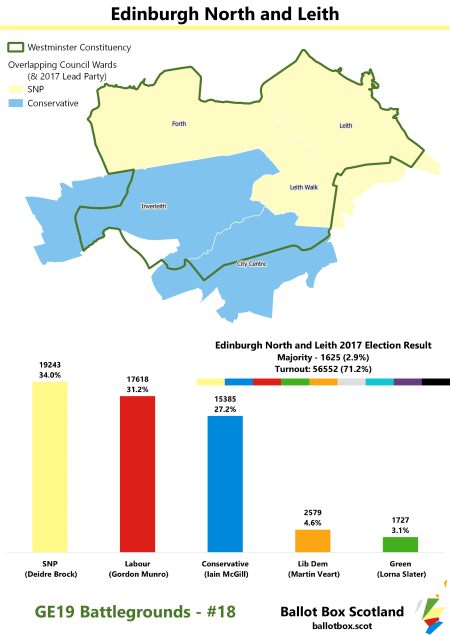Ballot Box Battlegrounds will be our trip through the 20 most marginal seats in Scotland, as the 2019 General Election approaches. Check out the GE19 Hub for the latest information!
[Button id=”11″]
#20 – Coatbridge, Chryston and Bellshill (Labour, Majority: 3.5%)
This North Lanarkshire seat allows us to kick off the Battlegrounds project in one of Scotland’s most interesting council areas. As with much of the rest of the western Central Belt, North Lanarkshire was an unassailable Labour stronghold for decades. And like some of those other strongholds, it voted Yes to Independence in 2014. Prevailing social media wisdom would have it that it should therefore be solidly SNP.
Although obviously included in their 2015 sweep, by 2017 the whole council area was actually much closer. In the council elections the month before the snap, Labour won a narrow lead in the corresponding wards. That probably helped set them up quite neatly for Hugh Gaffney to take the seat from the SNP. With a majority of just 3.5%, the fact this is the 20th most marginal seat in Scotland just emphasises how tight things are across the whole country.
In what is going to be a bit of a trend for Labour held seats in this series, whether they hold it currently looks reliant on either locally bucking the national trend or hoping that trend turns around by polling day a la 2017. Labour have been in a very weak polling position since May’s European Elections, potentially down as much as 10% on 2017, whilst the SNP have moved upwards. Just on those national polling figures this would seem like an easy SNP pickup.
If I were Labour I’d be putting more stock in the “bed in locally” strategy than “hope for a repeat of 2017”. North Lanarkshire may be one of the places that will see the least impact from a prospective Lib Dem bounce back, but with this snap inevitably centring around the issue of Brexit and much clearer fault lines than last time a dramatic mid-campaign recovery seems less likely. But on the local front Labour did win both council by-elections in wards within the constituency since 2017, most recently in September to replace Hugh Gaffney himself, which bodes well for local support.
#19 – Glasgow North (SNP, Majority: 3.1%)
Unbelievable as it may have been a few short years ago, not only is every seat in Glasgow a marginal, but most of them are so close they make it into the top 20. Glasgow North is the first of these that we’ll encounter as we go down this list, and the only one to have been anywhere near marginal pre-2015. In 2010 the Lib Dems were 13.2% behind Labour, pretty close by Glasgow standards, and current SNP MP Patrick Grady won just 12%.
It’s likely that result came from the socially mixed nature of the seat. Most of the West End of the city is included within the constituency, encompassing relatively affluent areas like Kelvindale, Kelvinside, Hyndland and Hillhead, plus the student heartlands around Glasgow University. Out towards the north of the seat, the likes of Maryhill and Summerston are more strongly working class. By 2017, the Greens (already strong in the area) had clearly supplanted the Lib Dems here, especially in and around Hillhead. Although they stood just three candidates in that year’s snap election, this constituency saw their best ever Westminster result.
The relative performance of those smaller parties could be interesting to watch in its own right here, but it remains between the SNP and Labour to actually take the seat. Labour’s Pam Duncan-Glancy may be disappointed that there’s only one bald, bespectacled Patrick on the ballot this time, having had a lot of fun with that during her campaign up against two of them in 2017.
For his part, Patrick Grady will probably be quite glad of fewer gags, as well as the relative strength of the SNP in recent polling. That would seem to bode well for his chances of retaining the seat with a much more comfortable margin than in 2017. Unless we do see another 2017 style turnaround for Labour, I doubt this one will be shifting.
#18 – Edinburgh North and Leith (SNP, Majority: 2.9%)
There’s something about Scotland’s two biggest cities and Norths, as there are a few parallels between Glasgow and Edinburgh’s Northern reaches (bracing for the impact of suggesting Leith is Edinburgh…) when it comes to elections. Edinburgh as a whole has always been more politically fluid than Glasgow, so the fact 2010 was an extremely close Lab-Lib Dem marginal will be less of a surprise.
Similarly, the Greens have substantial strength here and have displaced the Lib Dems at the council level, with councillors in two of the overlapping wards, and coming very close to winning a by-election for Leith Walk earlier this year. As is typical for the Greens though a strong local election showing did not translate to many Westminster votes, with the Lib Dems overtaking them again – albeit both still lost their deposits.
A final parallel is that mixture – common, in fairness, to many city constituencies – of the well-heeled and the working-class. The historic New Town alongside Stockbridge and Inverleith are rather affluent, whilst much of Leith as well as areas like Pilton and Granton still echo with the city’s industrial past. It’s that kind of demographic variation that leads to similarly diverse politics.
Unlike its Glasgow counterpart however, the Conservatives are a major force in this constituency. That’s evident based on the blue tint to a couple of the overlapping council wards, and in fact that party did so well here in 2017 that this is a three-way marginal, which would just need a 3.5% SNP-Con swing to flip it. Although Labour don’t show up as leading in any wards, they perform much better in the Leith wards than the Conservatives, which is what pushes them into second at both levels.
If current polling holds, this could be a messy one on the day – with the SNP the likely beneficiaries. Expect both Labour and the Conservatives to be pushing the usual “only we can stop the SNP here” messages over one another, whilst the Lib Dems combo of historic support plus a seeming revival in the polls may boost their numbers.
#17 – Central Ayrshire (SNP, Majority: 2.8%)
Combining south North Ayrshire and north South Ayrshire, this constituency divides quite sharply along those lines. The northern component is basically the town of Irvine and its surrounds, including the First Minister’s hometown of Dreghorn. As is the norm for Scotland’s former industrial centres, Irvine was typically a strongly Labour area before the SNP’s surge in support. Labour do still record solid support here, as evidenced by their lead in one of the three Irvine wards in the council elections.
Crossing the border into South Ayrshire, it’s a completely different story. The towns of Troon and Prestwick have been quite strongly Conservative for a good while now, consistently showing leads at council level since at least 2007, as well as being part of the Ayr constituency at Holyrood that’s been held by the party since 2000.
The wards fully within the constituency actually delivered a Conservative lead of about 4% over the SNP in 2017’s council elections, which they weren’t quite able to translate into a win here the next month. The most recent polling has the Conservatives almost back to where they were in 2017 and the SNP slightly improved, meaning this seat is going to be very much in contention.
This may come down to how many voters are turning out at each end of the constituency. Typically, the demographic that votes Conservative is more likely to turn out than SNP or Labour support, so a particularly strong result for the Conservatives in the south could spell doom for the SNP even if they hold onto their support in the north.







